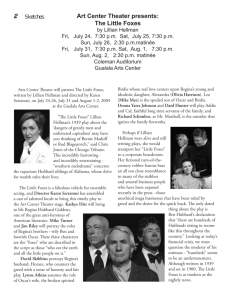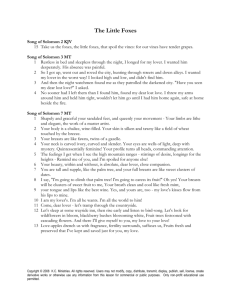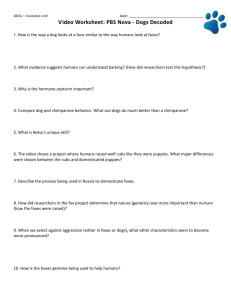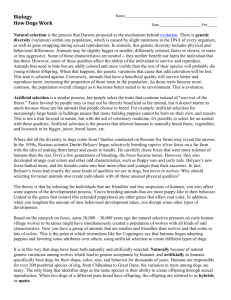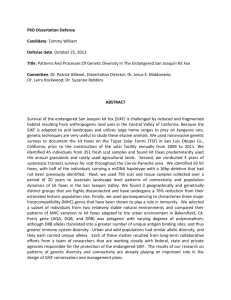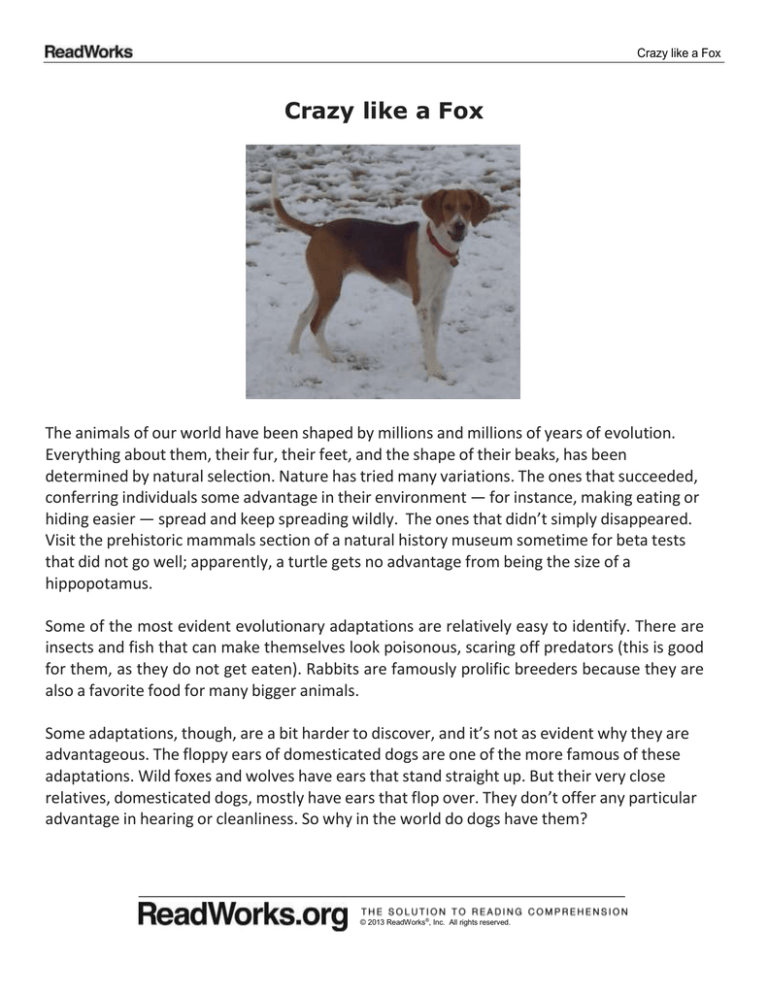
Crazy like a Fox
Crazy like a Fox
The animals of our world have been shaped by millions and millions of years of evolution.
Everything about them, their fur, their feet, and the shape of their beaks, has been
determined by natural selection. Nature has tried many variations. The ones that succeeded,
conferring individuals some advantage in their environment — for instance, making eating or
hiding easier — spread and keep spreading wildly. The ones that didn’t simply disappeared.
Visit the prehistoric mammals section of a natural history museum sometime for beta tests
that did not go well; apparently, a turtle gets no advantage from being the size of a
hippopotamus.
Some of the most evident evolutionary adaptations are relatively easy to identify. There are
insects and fish that can make themselves look poisonous, scaring off predators (this is good
for them, as they do not get eaten). Rabbits are famously prolific breeders because they are
also a favorite food for many bigger animals.
Some adaptations, though, are a bit harder to discover, and it’s not as evident why they are
advantageous. The floppy ears of domesticated dogs are one of the more famous of these
adaptations. Wild foxes and wolves have ears that stand straight up. But their very close
relatives, domesticated dogs, mostly have ears that flop over. They don’t offer any particular
advantage in hearing or cleanliness. So why in the world do dogs have them?
© 2013 ReadWorks®, Inc. All rights reserved.
Crazy like a Fox
In the 1950s, a man set out to answer this question. Dmitri Konstantinovich Belyaev was a
scientist in the 1950s, in Russia. At that time, Russia was the seat of a larger empire of
countries named the Soviet Union. During the 1950s, the Soviet Union was ruled by a man
named Joseph Stalin, notorious for brutally enforcing ideology and personal loyalty to him.
Scholars differ on how to tally the number of deaths under his relatively brief rule, including
everything from famines to people exiled to arctic prisons, but most estimates fall between
three and 30 million people.
Stalinist ideology favored a bizarre theory known as Lysenkoism over traditional notions of
evolution. Lysenkoism is hard to describe, but it centered on the idea that new traits in both
plants and animals were not found at birth, but rather developed over an organism’s lifetime
and then were passed on to its offspring. Soviet thinkers liked this theory, as it supported their
broader philosophical and political ideas that human nature was not inborn, and that the
Soviet socialist government could purge people of their anti‐government ideas (which they
considered inborn instincts) and build a civilization where everyone agreed with their ideology.
Lysenkoism would prove to be false in all its applications, and the word is today used as the
general term for faulty, ideologically‐corrupted science.
In the 1940s, however, this was the accepted state ideology. Konstantinovich did not believe in
it, and lost his prestigious job for carrying on research that did not conform to its ideals. This
did not stop him from pursuing his research. In the early 1950s, claiming to be conducting
research into animal psychology, Konstantinovich set up a huge facility in Siberia filled with
hundreds of cages. He filled those cages with silver foxes.
Konstantinovich was interested in domestication. He wanted to discover what accounted for
the physical, observable differences between wild animals and their domestic cousins. These
are not limited to floppy ears—spotted coats and curly tails are also much more common in
domestic animals. Konstantinovich had a theory that went all the way back to the advent of
animal domestication thousands of years in the past.
When humans first began an attempt to domesticate dogs (between 15,000 and 8,000 years
ago), they used them for a variety of things, from warmth to hunting to sanitation. Any
number of these traits could have been what early humans selected for: dogs with the best
sense of smell, dogs with the most fur to provide warmth, and so on.
What Konstantinovich thought, however, was that animals had been selected by early humans
based on their behavior. Specifically, he thought that early humans had picked the most docile
© 2013 ReadWorks®, Inc. All rights reserved.
Crazy like a Fox
and friendly animals for domestication. This makes a certain kind of intuitive sense. Think of
your own life: mostly, you would like to have a dog that is fun to be around (or at least one
you don't think will eat your family when you turn your back). It’s a long road, however, from
an idea that makes intuitive sense to something with the weight of scientific evidence behind
it.
To prove this, Konstantinovich and his team assembled hundreds of wild silver foxes at their
Siberian research facility. Their methodology was relatively simple. Any foxes that were
friendly to the researchers, whimpering, wagging their tails or licking their palms, were placed
in Class I. Any foxes that bit the researchers, ran away from them, or otherwise refused to be
handled, were placed in Class III (some were put in between, in Class II). The animals in Classes
I and II were allowed to breed. The animals in Class III were put down. The scientists repeated
this process again and again.
The results were startling. After just a few generations, the animals had become so docile that
the researchers had to invent a new category, Class IE, for those foxes that were so
domesticated they were basically indistinguishable from household pets. Along the way, they
started to notice other things happening to the foxes. Their coats became more spotted. Their
tails became curly. And, yes, their ears began flopping. The team theorizes these traits are
related to adrenaline production in the animals. Those that naturally produce less adrenaline,
making them less jumpy and therefore more suited for domestication, also tend to possess the
other traits we associate with domesticated dogs—droopy ears, curled tails and more.
Though Konstantinovich passed away in 1985, his team continues his work to this day. By 1999,
most of the foxes at the facility were in Class IE. In fact, one of the experiment’s primary
sources of revenue is selling their domesticated foxes as pets.
What can we learn from this experiment? Beyond offering a possible reason for dogs’ floppy
ears (no small accomplishment in itself), it allows us a chance to observe natural selection
happening in a small, controlled environment. The parallels are not perfect, obviously.
Humans replace nature as the enforcer of new adaptations, and the timeframe is much
shorter than it would be if the process were occurring naturally. Still, it is startling to see an
animal adapt and change. It offers us clues to how the rest of our world got the way it is —
animals doing their best to survive.
© 2013 ReadWorks®, Inc. All rights reserved.
Questions: Crazy like a Fox
Name:
Date:
1. What kind of animal did Dmitri Konstantinovich experiment with?
A
B
C
D
rabbits
hippopotamuses
turtles
silver foxes
2. An effect of Konstantinovich’s experiment is that the silver foxes became more docile
and friendly over time. What caused the foxes to become more docile and friendly over
time?
A Unfriendly foxes were allowed to breed, while friendly foxes were not allowed to
breed.
B Friendly foxes were allowed to breed, while unfriendly foxes were not allowed
to breed.
C All the foxes were allowed to breed.
D Only foxes in Class II were allowed to breed.
3. Foxes with less adrenaline are less jumpy. Foxes that are less jumpy tend to have
floppier ears.
What does this information suggest?
A
B
C
D
Foxes
Foxes
Foxes
Foxes
with
with
with
with
less adrenaline tend to have floppier ears.
more adrenaline tend to have floppier ears.
more adrenaline tend to be more friendly.
floppier ears tend to breed less.
4. How is Lysenkoism different from evolution?
A Lysenkoism is a theory still widely believed today; evolution has been proven
false.
B Lysenkoism is a theory that applies only to plants; evolution applies to plants
as well as other living things.
C Lysenkoism claims that animal traits are not inborn; evolution claims that they
are.
D Lysenkoism claims that animal traits are inborn; evolution claims that they are
not.
1
© 2013 ReadWorks®, Inc. All rights reserved.
Questions: Crazy like a Fox
5. What is this passage mainly about?
A a former leader of the Soviet Union who caused the deaths of at least 3 million
people while he was in power
B a scientific theory centered on the idea that new traits in plants and animals
develop over an organism’s lifetime
C prehistoric mammals in a natural history museum, such as turtles the size of
hippopotamuses
D an experiment showing how domesticated dogs may have developed some of
their traits
6. Read the following sentence: “When humans first began an attempt to domesticate
dogs (between 15,000 and 8,000 years ago), they used them for a variety of things,
from warmth to hunting to sanitation.”
What does the word domesticate mean?
A
B
C
D
become more common over time
die off as the result of climate change
kill for food
make a pet out of
7. Choose the answer that best completes the sentence below.
Konstantinovich was interested in domestication;
using silver foxes.
A
B
C
D
, he performed an experiment
therefore
third
like
never
8. According to the passage, what traits are associated with domesticated dogs?
2
© 2013 ReadWorks®, Inc. All rights reserved.
Questions: Crazy like a Fox
9. Based on the Konstantinovich’s experiment, why might droopy, floppy ears have
developed in dogs?
10. The passage states that Konstantinovich’s experiment shows “natural selection
happening in a small, controlled environment.” Explain how the experiment serves as an
example of natural selection. Support your answer with evidence from the passage.
3
© 2013 ReadWorks®, Inc. All rights reserved.
Teacher Guide & Answers: Crazy like a Fox
4
© 2013 ReadWorks®, Inc. All rights reserved.



